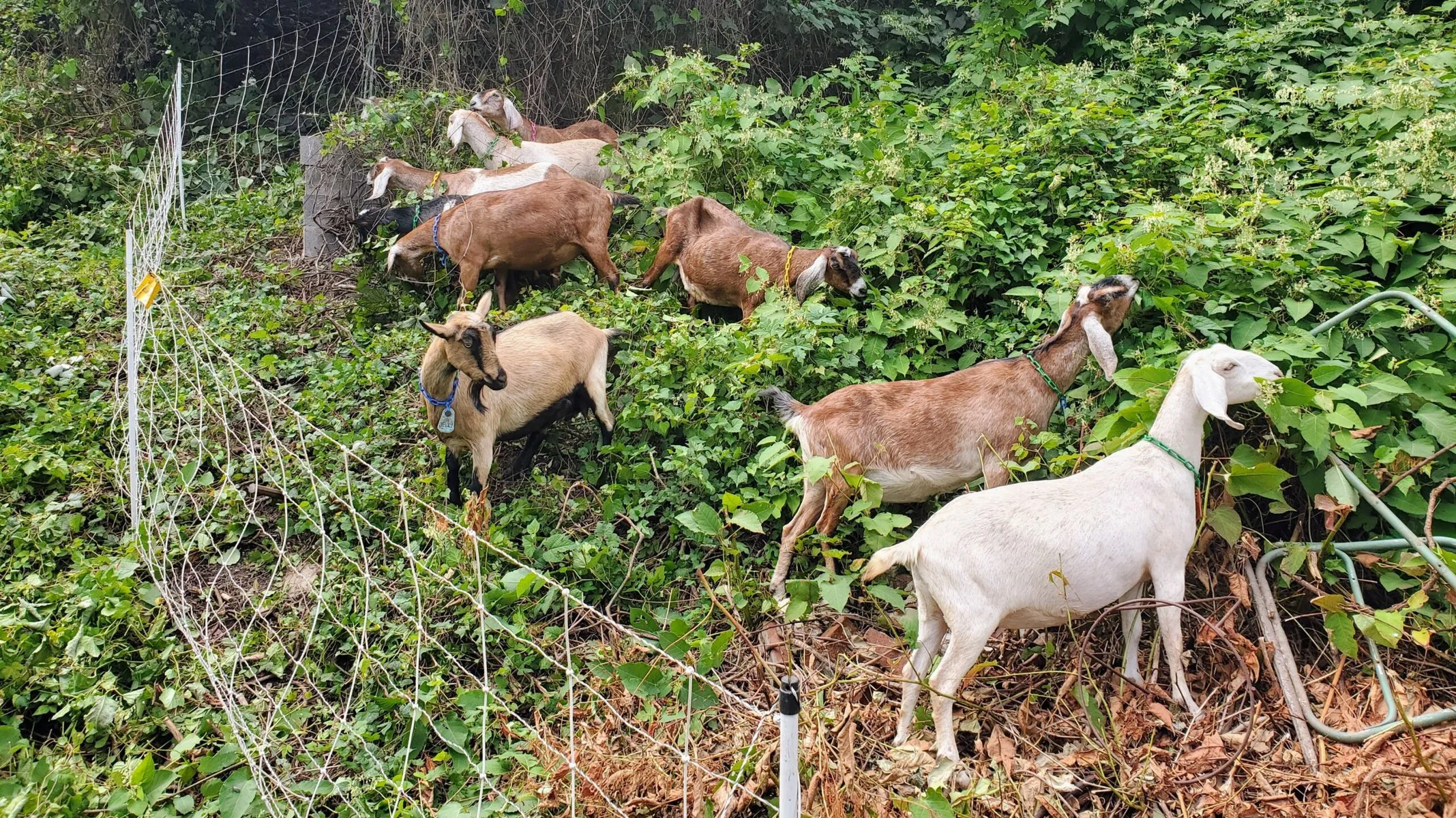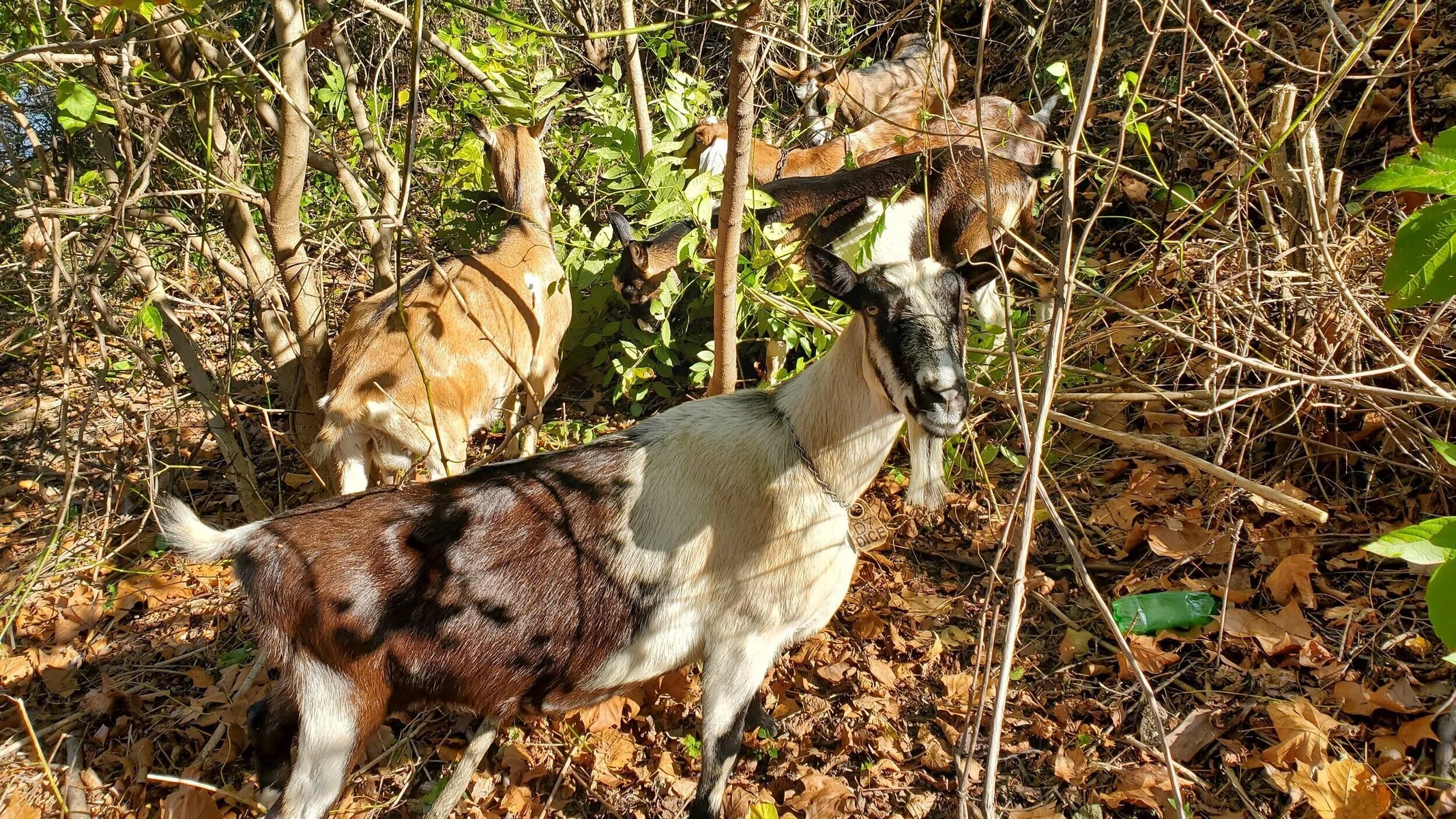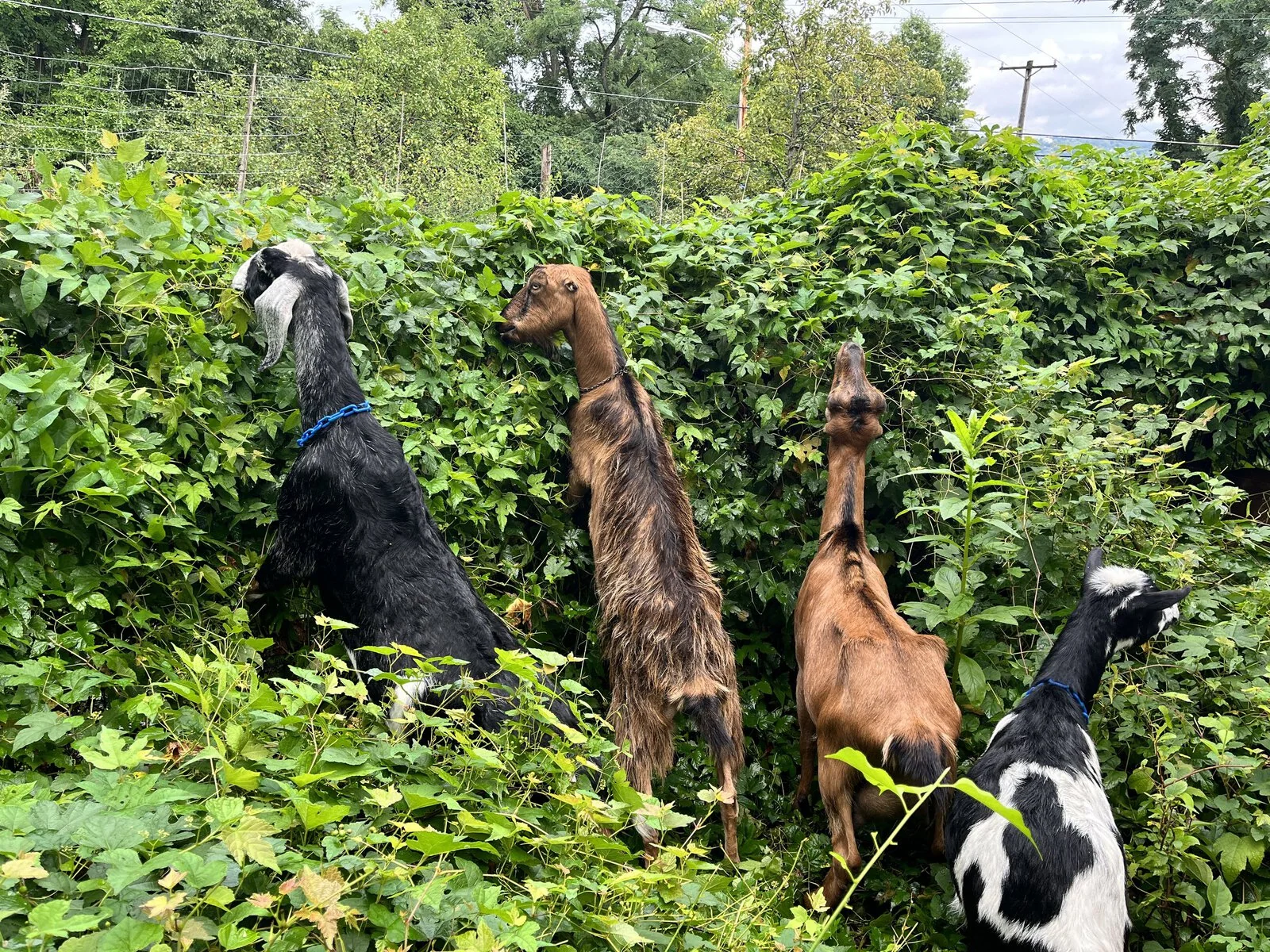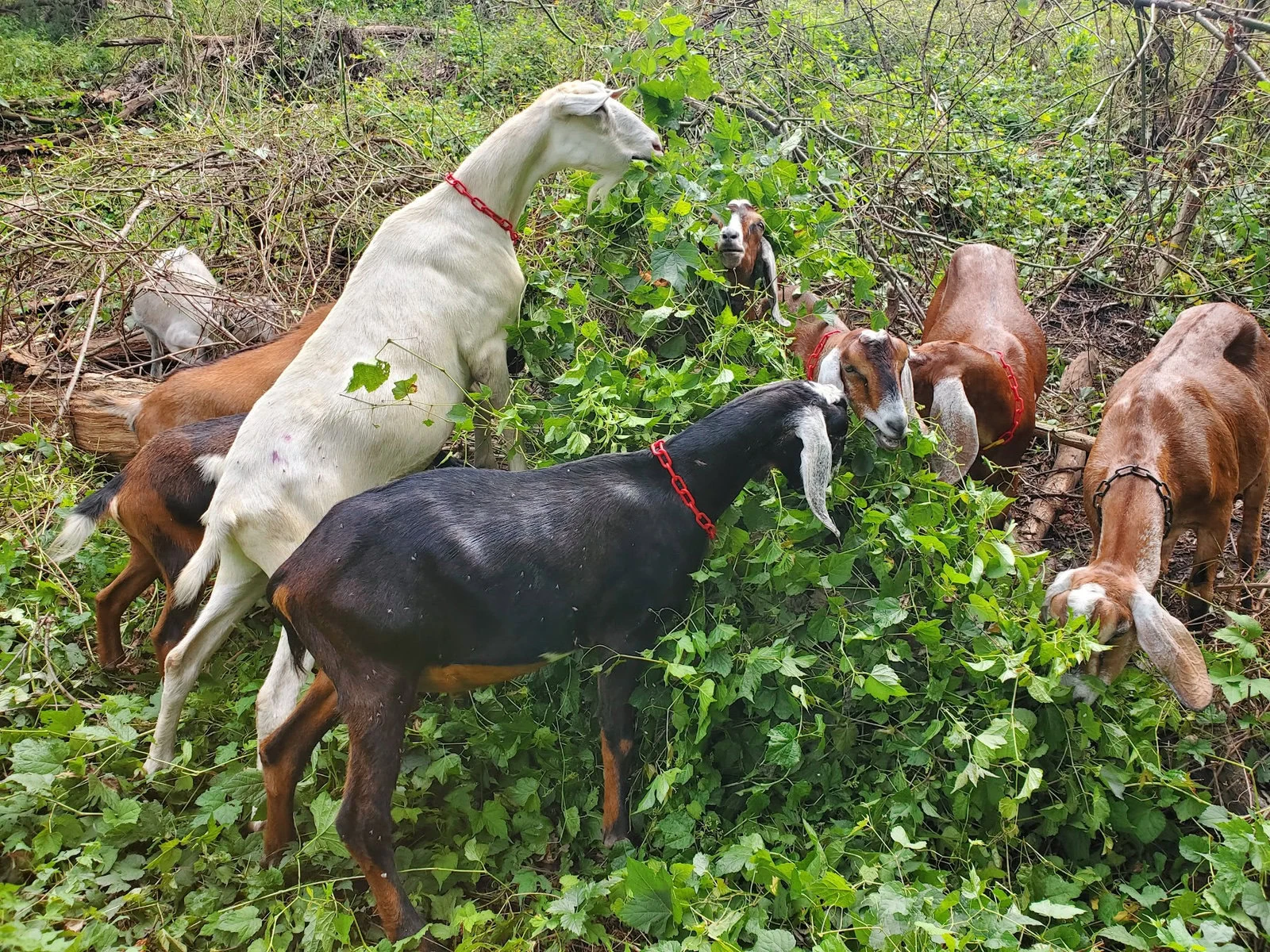If you take a stroll through a Pittsburgh city park, you might come across Hobo the donkey and his crew of 12 goats scrambling up an embankment or chowing down on poison ivy. Keep your dog on a leash, though, because Hobo doesn’t like canines, and he takes his job as protector of the herd very seriously. If he senses danger, he will round everyone up, then stomp, kick and bite to deter any predator that he deems a threat to his pals and the job they’ve been commissioned to do.
Hobo’s herd of goats is one of four Allegheny GoatScape hires out to landowners, businesses and nonprofit organizations in the Pittsburgh area to target plants designated by the Pennsylvania Department of Conservation and Natural Resources as invasive and damaging to the ecosystem. Knotweed, an invasive herb, and bittersweet vine, a plant that weighs down branches and in worst-case scenarios uproots the tree, are among the smorgasbord of plants goats will consume.

“By consuming a lot of biomass, goats significantly reduce the amount of vegetation that needs to be treated with herbicide products,” says Brandon McCracken, senior manager of ecological restoration for Pittsburgh Park Conservancy (PPC), a nonprofit group partnering with the City of Pittsburgh and local communities to improve the city’s park system.
Arriving at the worksite, the goats waste no time. Fences are erected to keep them away from the public and a shelter is put up. “We generally calculate that one acre of work takes roughly 12 or so days to complete,” says Gavin Deming, executive director of Allegheny GoatScape. “There’s a little variation based on topography. If it’s a steep hillside or there’s dense vegetation of vines and bushes it might take a bit longer.”
In many cities, herbicides have traditionally been used to eradicate unwanted vegetation. In New York, NYC Health reports that in 2022, liquid herbicide use increased by 177 percent, due to the treatment of invasive plants in city parks. Many herbicides, such as Round-Up, a popular weed killer, contain glyphosate, allegedly linked to cancer. Herbicides can remain in the soil and on plants, and during rain, they wash into streams and rivers, further contaminating the ecosystem.

“There’s a need for goats pretty much all across the U.S.,” says Aaron Steele, co-founder of Goats on the Go, a network of 75 affiliate goat businesses in 25 states — including California and New Mexico, where the goats aid in wildfire prevention. In the steep hills of California’s Sierra Nevada region, for instance, according to the California Wildfire and Forest Resilience Task Force, the changing climate is impacting annual weather patterns, causing drought and affecting snowpack accumulation and runoff. All this is putting the region at an increased risk of fire.
Goats are sure-footed, and they enjoy scrambling up steep terrain and getting to the vegetation that’s difficult for humans to eliminate. Considered browsers, goats prefer woody plants, soft shoots and shrubs as opposed to grazers, such as cows, who are happy chowing down on grasses and low-lying vegetation. This makes goats ideal to clear areas of high-growing woody plants that fuel wildfires.
Weighed down by negative news?
Our smart, bright, weekly newsletter is the uplift you’ve been looking for.“Historically,” says Cheryl Post, a natural environment specialist with the City of Toronto, “animals have shaped and maintained prairie and meadow ecosystems.”
Deer and bison brought nutrients to the soil through their wastes, reduced woody growth, prevented the spread of fires and enhanced native seed germination as their hooves stomped and aerated the soil surface. Goats mimic these actions on a smaller scale, which is why the City of Toronto initiated the Prescribed Goat Grazing Pilot Project for two days in June 2024. If left unmanaged, urban meadows, such as at Don Valley Bricks Works Park in Toronto, would become susceptible to the encroachment of woody vegetation (trees and shrubs) such as buckthorn. A small shrub found in the woodlands and open fields of Ontario, it forms dense stands under which few other plants can grow and eradicates habitats for both ground-nesting birds and wildflowers such as milkweed, a host plant for the larvae of the endangered monarch butterfly.

If Toronto decides, based on the pilot, to pursue goat-scaping, it will not become a panacea replacing other methods of land management.
“The idea of the goats is to be part of an integrated management system of best management practices,” Post says. These include mowing, prescribed burning and even chemical use. McCracken of the PPC concurs that goats are another tool in the toolbox, one that he’s happy to have.
There are challenges in asking goats to come to work for you. They have thin pelts and need shelter, which means in cold winter weather they aren’t able to work out in the open. They are able to break down seeds of invasive plants in their stomachs, so what is excreted does not spread the species they’re eating, but this also makes them susceptible to parasites such as stomach worms.

“Goats are very intelligent and very curious,” says Steele. “You can use that to your advantage because it drives them to search out the best food all the time.” A good and bad trait, it turns out. He can laugh about it now, but he’ll admit that fetching goats from the tops of trees — after they scramble up for juicy tidbits and get stuck — can be infuriating.
But in the scheme of things, these inconveniences are minor. A perk of Toronto’s goat grazing trial was the amount of public interest it received. Since the trial’s conclusion, Post has fielded inquiries from cities across North America on how to start a goat grazing project. One question that comes up frequently is how the animals are treated.
“The goats were friendly, not nervous, were well cared for, and happy to do what they were doing,” Post affirms.
Sometimes people will see a goat with a limp, and despite being assured that the injury has been treated, they will become very concerned about the animal’s welfare. “It’s less stressful for it to stay with the herd than take it home and isolate it,” Steele says. As herd animals, goats like having company.
People, it turns out, also like goats.
“Park visitors love seeing the goats at work; their presence brings a lot of joy and adds to the park experience!” says Alana Wenk, director of advancement for PPC. “The goats are always in a secure, enclosed area, accompanied by a protective donkey that keeps them safe from potential threats like coyotes or dogs.”






